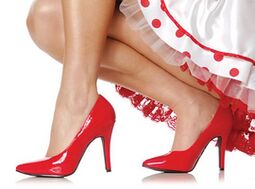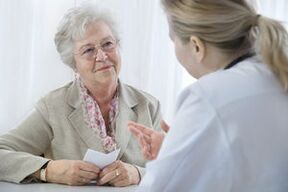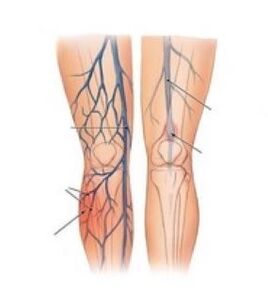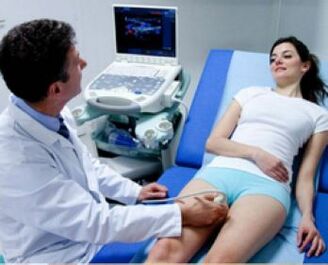Varicose veins are a common vascular disease that mainly affects women's legs. Its essence is the dilation or elongation of the vessels of the lower extremities, resulting in thinning of the venous walls. The disease cannot be ignored as it can cause serious complications such as venous insufficiency, thrombosis, bleeding and gangrene of the legs.
The disease cannot be ignored as it can cause serious complications such as venous insufficiency, thrombosis, bleeding and gangrene of the legs.
Gangrene is dangerous because if left untreated, it can lead to amputation of the legs, thrombosis and even death of the patient - a screaming blood clot reaches the heart, which can lead to arrest. It is important to treat the disease early, before complications develop.
Reasons
Scientists have proven that the tendency to varicose veins is inherited. If your relatives have been diagnosed with varicose veins, you are more likely to develop them.
The following reasons may contribute to its development:
- hormonal diseases;
- pregnancy;
- high loads on legs;
- bad habits;
- hypodynamics.
The main natural cause of varicose veins in the legs is the increased load on the veins. The load can occur due to both physical inactivity and increased physical activity.  Often, an office lifestyle leads to varicose veins - too much time is spent sitting or standing. In this case, blood circulation is disrupted, stagnant areas are formed, which subsequently leads to vascular degradation.
Often, an office lifestyle leads to varicose veins - too much time is spent sitting or standing. In this case, blood circulation is disrupted, stagnant areas are formed, which subsequently leads to vascular degradation.
An unhealthy diet also increases varicose veins. The cause of the disease may be increased consumption of fatty foods, fast food, cholesterol, caffeine. All this has a negative impact on vascular health. Excessive physical activity is also harmful.
Pregnant women are also at risk. The physical features of pregnancy often prevent the proper blood supply to the legs, which leads to the development of varicose veins. In addition to adequate blood supply to the legs, hormonal status changes in pregnant women, which can lead to disease. It is recommended to check the condition of the feet regularly during this period and consult a doctor immediately if there is pain. Inflamed veins may disappear after the birth of a child, but you can wear special draping underwear to prevent it.
symptoms
Using various symptoms, you may suspect the development of varicose veins:
- Swelling of the legs. Strengthening towards the end of the work day is a common feature.
- Calf pain is an early sign.
- Sudden leg cramps.
- Prolonged healing of wounds and bruises is a delayed symptom.
- Enlargement of blood vessels, the appearance of bypasses or nodules is an early sign.
- Hair loss on the inner surface of the legs, thickening of the skin in this area is a delayed symptom.

An important feature of the manifestation of symptoms is an increase in the evening or after standing for a long time or without moving. It is recommended that you see a doctor immediately if you find at least one symptom of the disease. Diagnosis of varicose veins is carried out by phlebologists - vascular specialists. A routine examination is not enough to make a diagnosis; Doppler ultrasound is needed. If necessary, varicose veins can be confirmed by radionuclide or radiopaque method. In this case, the distribution of the substance specifically applied to the vessels will be investigated.
Treatments

The spread of varicose veins has led to the development of many options for its treatment, both medical and folk. If possible, contact your doctor, who will tell you exactly how to treat you based on your individual characteristics. It is advisable to use folk remedies only in the absence of professional treatment. They eliminate the symptoms of the disease, but do not eliminate the cause.
Medication
All medications are divided into two major groups: local and general medications. It should be understood that drug treatment is associated only in the early stages of the disease. In advanced cases, drug treatment is also used only to prevent the spread of the disease.
Anticoagulants are the most popular treatment. They thin the blood, prevent vasodilation, which reduces the risk of clotting. It can be taken both orally and in the form of gels and ointments or injections. Dosage and choice of a specific drug can only be trusted by the attending physician. Angioprotectors help improve vascular microcirculation and thus eliminate the cause of the disease.
Leeches are also used to treat varicose veins. When you bite, hirudin, a special natural substance, enters the body. This dilutes the blood, which reduces the risk of blood clots. Although this method is less effective than medication, it is the only way available for some. Leech treatment is cyclical.
This dilutes the blood, which reduces the risk of blood clots. Although this method is less effective than medication, it is the only way available for some. Leech treatment is cyclical.
Surgical Treatment
The essence of surgical treatment is to remove or completely remove the patient's blood vessels from the circulatory system. Often such procedures are performed by injecting a special substance that sticks together from the inside of the vein. The most effective method, which is not dangerous to health, is the surgical removal of damaged blood vessels. At the same time, the general condition of the circulatory system will hardly suffer. The veins that cause varicose veins pass through only 10 percent of all the blood flowing in the legs. Removing them will load the rest of the arteries, but will not cause significant damage to health.
Alternative Treatment
Varicose veins can be treated with folk remedies, but at your own risk. Many of these methods are ineffective in the early stages of the disease, and ineffective in the later stages. Alternative therapies eliminate the symptoms of varicose veins, but do not cure them, which is especially dangerous in advanced cases. Such a trip is dangerous for your health.

Among the most popular folk recipes that can be used to treat varicose veins:
- Apple Cider Vinegar
- wormwood;
- nettle;
- garlic.
Apple cider vinegar can also cure inflammation in young people by eliminating inflammation. Painful spots are treated twice a day. Vinegar is diluted in a bath, put your feet in for 5 minutes. It is recommended that your feet dry on their own after such procedures. Garlic is used as an ointment. To prepare, mix one part of garlic with two parts of butter. The resulting gruel is applied to the affected areas of the legs at night.
Prevention
Prevention is universal and not only prevents varicose veins, but also improves overall health, relieves symptoms and consequently improves well-being.
Basic Preventive Measures:
- healthy food;
- to do sports;
- Lack of high loads on the arteries.
Healthy food includes the use of fruits and vegetables in the diet, especially raw products. Eating walnuts and seafood also has a beneficial effect on vascular health. In this case, you need to forget about high-fat and salty foods, products containing alcohol and caffeine.
Regular exercise improves blood flow in the legs, which has a positive effect on vascular health. Don't do too much sports - it's great for jogging and moderate cycling. Even during sedentary work, it is important to exercise regularly without allowing blood stasis. Cross-legged sitting is contraindicated.
Varicose veins are a disease that needs to be treated in the early stages. Do not hesitate to consult your doctor at the first symptoms. Today, the treatment of varicose veins in women's legs is not as expensive as before and is not dangerous for the body. By receiving pre-treatment, you will provide yourself with health and comfort on your feet for many years to come.













































